Workflow and lifecycle management
Fusion Manage requires a separate license and can be used with Fusion or independently. Learn more.
Lifecycles and workflows combine to form the basis of process management.
A workflow refers to the actions required to complete a managed process such as creating, reviewing, and approving change orders or analyzing problem reports. A workflow consists of states and actions.

Workflow states
A state is a stop along the workflow path. States are represented as boxes on the workflow map. All change management processes are in a workflow state at any given time. The current state is highlighted blue on the workflow map.
Actions
A workflow action is the path connecting one state to another and represents the action required to enter a state. Workflow actions are represented as arrows on the map. A state may have one or more possible actions for you to perform. The available actions are based on the current state and your workflow permissions. Available actions are indicated as bold paths leaving the current state. When an item reaches a new workflow state, one or more actions may become available depending on the workflow.
Workflow notifications
Everyone with permission to take a workflow action, as well as the item owners, will receive an email indicating the available and completed actions.
Lifecycle management
While workflows track the progress of change orders, change requests, problem reports or change tasks, lifecycle states track the revisions of designs and drawings.
Revising items and moving them through the product lifecycle is accomplished using change management processes. When a design or a drawing item is attached to a change order, the item can be revised. As a change order progresses through the approval workflow, the items attached to the change order progress through the product lifecycle states.
Lifecycle states
The lifecycle states are:
| Lifecycle State | Description |
|---|---|
| Unreleased | Design iterations are being made for the release of the first revision of the design or drawing. |
| Pre-Production | The item is being prepared for release to Production. Change orders are used to track critical design changes or a minor revision can be made with a quick release. Tracked iterations create numbered revisions. A change order is required to go to Production. |
| Production | The item is released to manufacturing. Design changes require a change order and create lettered revisions. |
| Obsolete | The item has reached its end-of-life and is no longer produced or has been discarded. A change order is required to move an item to Obsolete. |

Items attached to change orders move to the next lifecycle state as the change order progresses.
Quick release
A design or drawing can go from Unreleased to Pre-production without requiring a change order. Likewise, design iterations in the Pre-Production lifecycle state do not require a change order. This is called Quick Release and means that reviewers and approval are not necessary to move from Unreleased to Pre-Production or to create minor, untracked revisions in Pre-Production. The quick release paths are shown as orange on the lifecycle map.
Change management
Use change management to manage changes quickly and efficiently. You will keep stakeholders informed about upcoming changes at the right time. Change management manages electronic approvals and provides full traceability for all activities.
You will have access to these change management processes:
- Change requests - Use it to propose a change to an item.
- Change orders - Create one to control the revision of one or more items. They follow the change approval workflow and can be created from a change request or can be created independently.
- Problem reports - Helps you document, analyze, and resolve issues.
- Change tasks - Create them to manages tasks for change requests and change orders.
Working versions, revisions, and superseded items
Changes to design and drawing items occur only to the latest working version. In either case, changes are applied to the working version.
An Unreleased lifecycle state is a indicator that the overall maturity of the component or drawing is in it's infancy and hasn't been promoted to pre-production or production state.
Revisions are created when a design or drawing item is in either the Pre-Production state or the Production state. Iterations on pre-production items are identified with revision numbers. For example, REV 1, REV 2 and so on. Iterations on items released to production are identified with revision letters. For example, A, B, C, and so on.
When a released item is revised, the previous release is replaced or superseded and all references to this item are updated to point to the new revision once it is released.
States
You can look at the State field in the Properties panel to understand the status of your design or drawing revision. The product determines the state based on a variety of factors. See the list below to understand the states and what they mean.
| State | Description |
|---|---|
| Working | Items are being worked on. |
| Pending release | Items are in the review state in a change order. |
| Released | Items are released and the change order is approved. |
| Superseded | A newer revision available for the item. |
